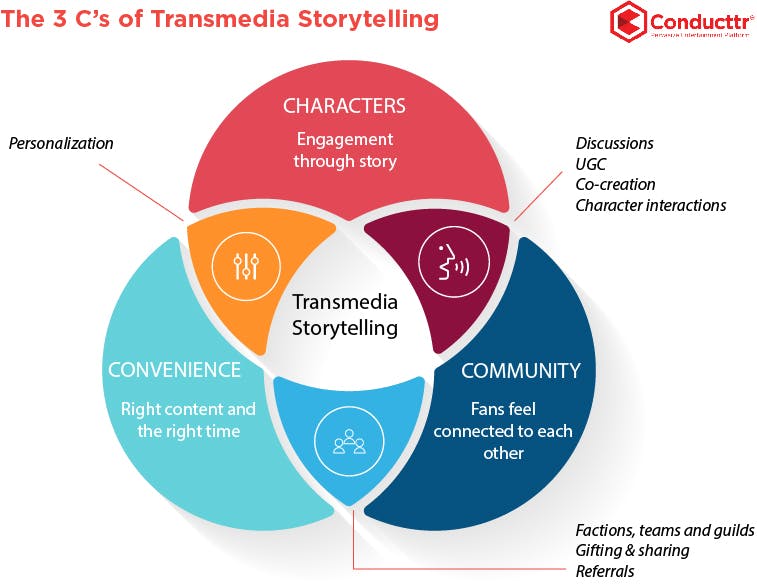Check out what's new:
Part 1: Transmedia storytelling and character integrity
In part 1 of this blog series, we explore how the primacy of characters in transmedia storytelling creates challenges with character consistency – especially given the increasingly distributed way transmedia properties are produced.

Transmedia storytelling is the future.
Valuable IP doesn’t just jump from the silver screen to a TV series or video game anymore. Instead, gaming native IP like Halo and League of Legends evolve into TV series – or even a virtual K-pop girl group. TV shows become in-person immersive events with original storylines, special merchandise, and photo ops like Stranger Things: The Experience. And movie IP? Well, a popular cinematic universe like Marvel might create a number of TV series that are only tangentially related to their films like WandaVision, Ms. Marvel, and She-Hulk: Attorney at Law.
It’s not just trilogies, remakes, spin-offs, and adaptations growing out of valuable IP and then extending across mediums these days. It’s the creation of dynamic story ecosystems where each new piece of media tells a different part of the narrative.
In this two part blog series, we’ll first explore how the primacy of characters in transmedia storytelling creates challenges – especially given the increasingly distributed way transmedia properties are produced. Then, in the second post, we’ll explore what character integrity looks like in the transmedia age and what role AI characters could play.
Transmedia storytelling: The final frontier

Transmedia storytelling is, according to Matthew Ball, the author of The Metaverse and How it Will Revolutionize Everything, the “final frontier of storytelling.”
“Historically, we defined an entertainment company around its core offering. Marvel was a comic book company, Mattel a toy company, ESPN a sports network, etc… Even Walt described Disney as a movie company,” he wrote in a 2021 post about IP and storytelling. “It’s clear today that these company definitions are no longer right.”
Instead, he argues, all these companies are now primarily ‘entertainment companies.’ Their job is to create and tell stories, build love for those stories, and then monetize that love. In the next evolution of media and transmedia entertainment, characters will be even more critical as they become the core drivers of the story worlds at the heart of this new breed of entertainment transmedia companies.
The challenge, of course, will be that this ascendency of characters will be happening at the same time that the job of nurturing those characters becomes more distributed – with a growing number of production companies, publishers, actors, writers, studios, and technologies involved in creating fan experiences across a variety of mediums for each transmedia franchise.
The 3 Cs of transmedia storytelling

Deploying transmedia’s distributed story worlds successfully requires what some call the three ‘Cs’ of transmedia storytelling: character, convenience, and community. Essentially, transmedia storytellers have to engage people through compelling characters, create the right (or convenient) content at the right time, and also build a community where fans feel connected to each other and the IP.
But with characters being the cornerstone of transmedia franchise success – character consistency becomes a core concern. What happens if a piece of a franchise’s content universe breaks character? It would likely lead to fan pushback – which could even (temporarily or permanently) devalue the transmedia franchise in question. Indeed, telling a story about a beloved character in the wrong way could have severe consequences for IP.
Why character integrity matters for transmedia companies

The concept of character integrity got its start in the 1930s. That’s when a young girl wrote to Walt Disney to ask an innocent question: How many Mickey Mouses were there? She had seen Mickey in so many places, she believed there must be more than one.
Nowadays, Disney theme parks have what they call the Rule of One. That means there can only ever be one version of a character in the park at a time. That’s because there *is* only one Mickey or Ariel or Buzz Lightyear. But character integrity goes deeper than that – character performers also can’t break character, be seen with their costume half-on, or publicly mention they play a character at a Disney park.
Walt Disney’s response to the little girl was that just like there is only one Santa, there is only one Mickey. That’s important for transmedia characters – even when transmedia isn’t so narrowly focused around the idea of retelling exactly what came before. The beauty of the next generation of transmedia franchise characters is that they’re iterating on past stories – not copying them.
Character integrity and fan co-creation

The differentiator between a successful and unsuccessful transmedia project isn’t just character integrity anymore, although that’s part of it. Brands that are successful across transmedia franchise projects rigorously ensure the consistency of their characters across mediums. But they also understand the ways their characters are now co-created with fans – a level of interactivity that represents a departure from Walt’s 1930s Mickey.
Dr. Clare Elizabeth Parody, an expert in transmedia franchise characters, defines them as ‘producerly’ characters that exist beyond any text. “Participatory culture expresses not a one-way dynamic but a feedback loop,” she says in her thesis on the subject. Parody sees the contemporary franchise character as a product of audience desires and interactions, as well as IP holders’ decisions.
Increasingly, she argues, fanfiction, cosplay, and other non-canonical character-focused creative expression is a key part of a more collaborative creative process. The future of IP is a balance between character integrity and character evolution through fan co-creation. Call it the Rule of One for the decentralized Web3 age.
AI characters and character consistency
With all of these challenges facing modern entertainment transmedia companies, AI characters present exciting opportunities to better navigate character integrity in transmedia storytelling. Wednesday, we’ll delve into how they can help create consistent character experiences across properties while generating real-time data and leveraging fan interactions to build more successful transmedia franchise extension strategies.
Curious about Inworld characters? Try your hand at creating one in our no-code AI character studio today.